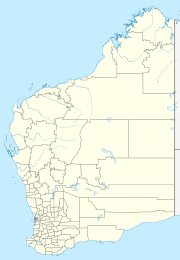Wollergerberleng Community facts for kids
Quick facts for kids WollergerberlengWestern Australia |
|||||||||
|---|---|---|---|---|---|---|---|---|---|
| Postcode(s) | 6743 | ||||||||
| Elevation | 47 m (154 ft) | ||||||||
| Location | 12 km (7 mi) south west of Kununurra | ||||||||
| LGA(s) | Shire of Wyndham-East Kimberley | ||||||||
| State electorate(s) | Kimberley | ||||||||
| Federal Division(s) | Durack | ||||||||
|
|||||||||
Woolergerberleng is a small Aboriginal community in Western Australia. It is located near the town of Kununurra, in a part of the state called the Kimberley region. It's part of the Shire of Wyndham-East Kimberley, which is like a local council area.
Contents
About Woolergerberleng
Woolergerberleng is also known as Hollow Springs. It was started in the 1980s. The first homes were built by the people themselves. They did not have electricity or running water at first. Life was simple, but people liked having their own space away from town. You can still see parts of the original camp today.
What is Native Title?
The Miriuwung Gajerrong people are the traditional owners of the land where Woolergerberleng is located. They signed an important agreement called the Ord Final Agreement. This agreement helps the Miriuwung Gajerrong people work together with the Western Australian Government and other groups. It helps them plan for the future of the East Kimberley region.
How the Community is Governed
A group called Yawoorroong Miriuwung Gajerrong Yirrgeb Noong Dawang Aboriginal Corporation, or MG Corp, helps manage things for the Miriuwung Gajerrong people. MG Corp makes sure that the promises made in the Ord Final Agreement are kept. This includes things about community living areas.
MG Corp was officially formed in 2006. Only people who hold native title can be members of MG Corp. This group helps the Miriuwung Gajerrong people plan how to use their traditional lands.
Planning for the Future
Woolergerberleng has a special plan called Layout Plan No.1. This plan helps decide how the community will grow and be organized. It follows rules set by the State Planning Policy 3.2 Aboriginal Settlements. The community approved this plan on November 16, 2010. The Western Australian Planning Commission also approved it on September 29, 2010. You can find more details about this plan on the Planning Western Australia website.


